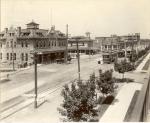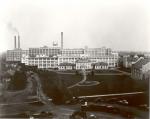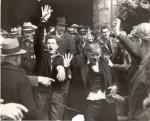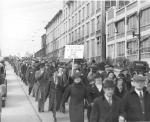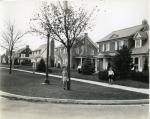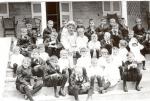![header=[Marker Text] body=[Marker Text: Hershey's Chocolate Workers Local 1 (CIO) responded to a labor-management impasse on April 2, 1937 by initiating the first sit-down strike in Pennsylvania and in the confectionery industry. The strike was ended by strike-breaking violence and government mediation. The union lost two subsequent representative elections. In 1939 workers affiliated with the Bakery and Confectionery Workers Local 464 (AFL). ] sign](http://explorepahistory.com/kora/files/1/10/1-A-320-139-ExplorePAHistory-a0l2n2-a_450.jpg)
Mouse over for marker text
Name:
Chocolate Workers' Sit-down Strike
Region:
Valleys of the Susquehanna
County:
Dauphin
Marker Location:
Cocoa Ave. near Caracas Ave., Hershey
Dedication Date:
September 10, 2005
Behind the Marker
In 1937, a series of strikes among hosiery workers in Reading, textile workers in Philadelphia, and steel workers in Johnstown and Bethlehem rocked Pennsylvania. Perhaps the most unexpected was a sit-down strike by workers at the Hershey Chocolate Company in Hershey, PA, for this job action, more than any other in the state, and perhaps the nation, demonstrated the failing grip of industrial paternalism upon the hearts and minds of the nation's industrial workers.
To offer alternatives to the harsh, exploitative practices of the American free market system, a small but significant of idealistic businessmen in the early 1900s decided to run their businesses on Christian principles of charity and benevolence-and to cement their workers' loyalty to their companies rather than unions. In Pittsburgh, Andrew Carnegie in his later years gave away most of his fortune building libraries and funding charitable projects. In
Andrew Carnegie in his later years gave away most of his fortune building libraries and funding charitable projects. In  Vandergrift, George G. McMurtry built a model town for the workers of the Apollo Iron and Steel Company. As part of its well-publicized experiments in welfare capitalism, U. S. Steel offered employees the "carrot" of stock ownership, pension plans, accident insurance, housing, and company-funded athletic programs in
Vandergrift, George G. McMurtry built a model town for the workers of the Apollo Iron and Steel Company. As part of its well-publicized experiments in welfare capitalism, U. S. Steel offered employees the "carrot" of stock ownership, pension plans, accident insurance, housing, and company-funded athletic programs in  Duquesne and other steel towns.
Duquesne and other steel towns.
In Philadelphia, John B. Stetson provided a broad range of services and activities for the thousands of workers at his Stetson Hat factory, including a hospital, boy scout troops, Americanization classes, and annual Christmas turkeys. None of them, however, put Christian ideals into practice on as grand a scale or with as much success as confectioner Milton S. Hershey.
In the early1900s, Hershey built a factory and then a city on farm fields in Dauphin County, Pennsylvania. By the 1920s, Hershey was the world's largest producer of milk chocolate, and his town an international model of the high quality of life that could be afforded by enlightened industrialists.
Hershey was the world's largest producer of milk chocolate, and his town an international model of the high quality of life that could be afforded by enlightened industrialists.
During the Great Depression, Hershey's workers kept their jobs and enjoyed the other amenities in their community because Americans continued to consume millions of Hershey bars. To bolster employment in his town, Hershey hired 600 workers and embarked on a massive building campaign that included construction of the Hershey Hotel, the Hershey Theatre, and the Hershey Arena.
The relative prosperity of Hershey did not, however, insulate it from the labor activism then sweeping the nation. The Depression cut the Hershey Chocolate Company's revenues in half, which forced the company to cut workers hours. Hershey hired, fired, and promoted workers as he saw fit, and the chocolate factory restricted many Italian-born workers to lower-wage jobs.
When C.I.O. organizers came to Hershey early in 1937, several hundred sympathetic workers joined the United Chocolate Workers local, which in March persuaded management to raise minimum wage rates. When Hershey laid off "seasonal workers" a few weeks later, union leaders believed that the company was punishing union men.
C.I.O. organizers came to Hershey early in 1937, several hundred sympathetic workers joined the United Chocolate Workers local, which in March persuaded management to raise minimum wage rates. When Hershey laid off "seasonal workers" a few weeks later, union leaders believed that the company was punishing union men.
On the morning of April 2, union president Russell "Bull" Behman waved a red handkerchief in front of the plant, and more than 600 workers sat down and stopped working. Hershey immediately rushed his attorneys over to the plant to negotiate a settlement, but both sides were far apart.
The strike was well-organized and civil. The union coordinated food shipments and ensured discipline on site to prevent the destruction of property that would give officials an excuse to evict them. Local sentiment, however, was firmly on the side of the company and its founder. Many workers and most of the town's people remained loyal to Hershey, and the strike threatened the livelihoods of local farmers in six counties, who sold the Hershey plant an estimated 60,000-70,000 gallons of milk each day.
Convinced that the C.I.O. was a communist organization, members of the company-sponsored Loyal Workers Club believed the factory had been taken over by dangerous, un-American agitators, a notion reinforced the next day when the Hershey strikers displayed a C.I.O. flag above the Stars and Stripes on the company flagpole.
On the evening of April 6, farmers, antiunion Hershey employees, and members of various patriotic groups marched in nearby Palmyra. The union, they argued, not only dishonored the heroic Hershey, it was outright un-American. On April 7th, still without resolution, loyal workers and local farmers held a parade downtown to show their support of Hershey.
That morning, Hershey farmers and loyal workers sent an ultimatum to the strikers: "Evacuate by twelve noon or suffer the consequences." Just before 1 p.m., union representatives met with the company president and agreed to end the strike. An antiunion crowd of 3,000, however, had already gathered at the factory with baseball bats, pitchforks, and lead pipes. After exchanging taunts and insults with the strikers, the crowd began to storm the plant and fleeing workers fled through a gauntlet of blows. When the fighting was over, twenty-five striking workers had been soundly beaten, and some taken to the local hospital to be treated for their injuries.
The political response was immediate. Governor George H. Earle called the incident "a disgrace," and blamed the Derry Township sheriff for not stopping the mob from entering the building. The National Labor Relations Board (NLRB) arrived to supervise new elections. Two weeks later, Hershey's workers selected a new independent union, the Independent Chocolate Workers (ICW), rather than the C.I.O. to represent them.
George H. Earle called the incident "a disgrace," and blamed the Derry Township sheriff for not stopping the mob from entering the building. The National Labor Relations Board (NLRB) arrived to supervise new elections. Two weeks later, Hershey's workers selected a new independent union, the Independent Chocolate Workers (ICW), rather than the C.I.O. to represent them.
Two years later the NLRB ruled that the ICW was an illegal company union and ordered Hershey to allow its workers another vote. Still shying away from the CIO, Hershey workers formed the Local 464 of the Bakery and Confectionary Workers Union, affiliated with the more conservative American Federation of Labor.
After the 1937 strike, Milton Hershey, now in his eighties, further removed himself from the everyday workings of the company and town. "The strike changed him," said Richard Murrie (the president of Hershey Chocolate Company in 1937). "He was deeply hurt and felt all he had done for the town had been forgotten." That, however, would not happen.
In 1918, Hershey had placed his personal fortune and control of the company in the Hershey Trust, which administered the Milton Hershey School for orphaned boys, which Hershey had founded in 1909. Hershey's Trust, worth more than $5 billion in 2005, would continue to shape the town of Hershey and direct the company into the twenty-first century.
To offer alternatives to the harsh, exploitative practices of the American free market system, a small but significant of idealistic businessmen in the early 1900s decided to run their businesses on Christian principles of charity and benevolence-and to cement their workers' loyalty to their companies rather than unions. In Pittsburgh,
In Philadelphia, John B. Stetson provided a broad range of services and activities for the thousands of workers at his Stetson Hat factory, including a hospital, boy scout troops, Americanization classes, and annual Christmas turkeys. None of them, however, put Christian ideals into practice on as grand a scale or with as much success as confectioner Milton S. Hershey.
In the early1900s, Hershey built a factory and then a city on farm fields in Dauphin County, Pennsylvania. By the 1920s,
During the Great Depression, Hershey's workers kept their jobs and enjoyed the other amenities in their community because Americans continued to consume millions of Hershey bars. To bolster employment in his town, Hershey hired 600 workers and embarked on a massive building campaign that included construction of the Hershey Hotel, the Hershey Theatre, and the Hershey Arena.
The relative prosperity of Hershey did not, however, insulate it from the labor activism then sweeping the nation. The Depression cut the Hershey Chocolate Company's revenues in half, which forced the company to cut workers hours. Hershey hired, fired, and promoted workers as he saw fit, and the chocolate factory restricted many Italian-born workers to lower-wage jobs.
When
On the morning of April 2, union president Russell "Bull" Behman waved a red handkerchief in front of the plant, and more than 600 workers sat down and stopped working. Hershey immediately rushed his attorneys over to the plant to negotiate a settlement, but both sides were far apart.
The strike was well-organized and civil. The union coordinated food shipments and ensured discipline on site to prevent the destruction of property that would give officials an excuse to evict them. Local sentiment, however, was firmly on the side of the company and its founder. Many workers and most of the town's people remained loyal to Hershey, and the strike threatened the livelihoods of local farmers in six counties, who sold the Hershey plant an estimated 60,000-70,000 gallons of milk each day.
Convinced that the C.I.O. was a communist organization, members of the company-sponsored Loyal Workers Club believed the factory had been taken over by dangerous, un-American agitators, a notion reinforced the next day when the Hershey strikers displayed a C.I.O. flag above the Stars and Stripes on the company flagpole.
On the evening of April 6, farmers, antiunion Hershey employees, and members of various patriotic groups marched in nearby Palmyra. The union, they argued, not only dishonored the heroic Hershey, it was outright un-American. On April 7th, still without resolution, loyal workers and local farmers held a parade downtown to show their support of Hershey.
That morning, Hershey farmers and loyal workers sent an ultimatum to the strikers: "Evacuate by twelve noon or suffer the consequences." Just before 1 p.m., union representatives met with the company president and agreed to end the strike. An antiunion crowd of 3,000, however, had already gathered at the factory with baseball bats, pitchforks, and lead pipes. After exchanging taunts and insults with the strikers, the crowd began to storm the plant and fleeing workers fled through a gauntlet of blows. When the fighting was over, twenty-five striking workers had been soundly beaten, and some taken to the local hospital to be treated for their injuries.
The political response was immediate. Governor
Two years later the NLRB ruled that the ICW was an illegal company union and ordered Hershey to allow its workers another vote. Still shying away from the CIO, Hershey workers formed the Local 464 of the Bakery and Confectionary Workers Union, affiliated with the more conservative American Federation of Labor.
After the 1937 strike, Milton Hershey, now in his eighties, further removed himself from the everyday workings of the company and town. "The strike changed him," said Richard Murrie (the president of Hershey Chocolate Company in 1937). "He was deeply hurt and felt all he had done for the town had been forgotten." That, however, would not happen.
In 1918, Hershey had placed his personal fortune and control of the company in the Hershey Trust, which administered the Milton Hershey School for orphaned boys, which Hershey had founded in 1909. Hershey's Trust, worth more than $5 billion in 2005, would continue to shape the town of Hershey and direct the company into the twenty-first century.





